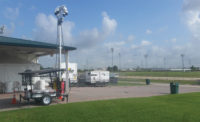Anyone who’s ever tried to build something or work on a vehicle knows the importance of having the right tools for a specific job. While some tools will get the job done, others can do it more effectively. A mechanic with a lug wrench can remove a wheel, but if he is going to have a profitable garage, he needs to quickly remove many wheels every day. For him, a good air compressor and pneumatic impact wrench would be a wise investment.
For security technicians and installers, it is just as important to have the right tools for the right jobs. SDM spoke with several security professionals and asked them about their recommendations for tools of the trade.
Mike Strelczyk, installation manager, Alarm Detection Systems Inc. (ADS), Aurora, Ill., says ADS provides a tool allowance for technicians to buy their own tools for the job. “We approve the purchases made using the tool allowance by making sure it is a tool that can be used primarily in our industry,” Strelczyk says. “Multimeters, hand tools, drills and labor-saving devices (such as glow rods, chimney sweep rods, and telescoping wire-grabbing poles) are all examples of items approved to buy.”
Tom Soper, president of Platinum Alarms, Bayonne, N.J., looks for heavy-duty tools that are tried and true in the field. “I choose most brands that have a lifetime warranty or a no-questions-asked repair service. I can’t afford to pay a tech to be on site waiting for a broken tool replacement or taking too long because he doesn’t have the correct tool.”
Strelczyk’s recommended tools for burglar alarm service and installation are a smartphone app and a multimeter, while Soper finds a glass-break simulator valuable.
Wes Usie, founder and CEO of Guardian Alarm Systems, Shreveport, La., says in the area of burglar alarms, most alarm systems can be serviced easily with two simple tools. First, a common voltage meter: “Many problems with burglar alarms are a result of voltage drop due to long wire runs or cabling that is too small for the connected device,” Usie says. “Using a voltage meter to ensure the panel is providing proper voltage and the device is receiving the proper voltage lets a technician know each is functioning properly.”
The second, Usie says, is a continuity tester. “This tool allows a technician to test an alarm circuit with a loud audible sounder while he or she is in another area of the home or business. Most voltage meters have this functionality [to test continuity] as well, but the loud noise this tool provides is very helpful when an installer or technician is working alone.”
Besides these two tools, Usie says a pair of side cutters, screwdrivers and a spare magnet have also proved to be very helpful when installing or servicing a burglar alarm.
John Loud, president of LOUD Security Systems, Kennesaw, Ga., has found the most helpful tools for installing and servicing burglar alarms to be glow rods, toner, volt meters and butt sets, also called a linesman’s handset. When buying tools, Loud says he looks not just at a tool’s capabilities and pricing, but also at the product’s warranty.
When it comes to video surveillance, Usie has a few suggestions: “With the rise of surveillance systems that provide HD video over coax cable, an installer needs a good coax stripper and compression tool. A compression tool can be somewhat expensive but minimizes time and also ensures very few return service calls because a BNC connector is loose.”
If installing IP cameras, Usie says, a Cat5 tool is a must. “[A Cat5 tool] allows an installer to crimp and connect network cables to cameras and the switch that provides network access to the camera. A Cat5 wire map tool can be helpful when an installer has problems with network connectivity on a camera. This can quickly let the installer know that the problem is or is not a result of the wiring.” (For more on Cat5/Cat6 cables and tools, see the article “Countless Service Calls the Result of Poor Cable Handling & Terminations” (December 2015, p. 135 and online at www.SDMmag.com/articles/countless-service-calls.)
Loud recommends for video surveillance a RJ45 crimper/network tester, a BNC crimper and portable monitors. Strelczyk also advises technicians carry a handheld monitor and a network wire tester.
For access control, Strelczyk says a multimeter is a must, and he also suggests having cordless power tools on hand. Usie finds voltage meters and continuity testers helpful in this area as well, and Loud adds that installers should carry concrete and metal drill bits.
In the area of fire alarms and detection, Loud says to have available a volt meter, a can of smoke, and a decibel noise level meter, while Soper recommends a phone butt set.
Usie adds that a smoke detector tester allows a technician to test a smoke detector from the ground without climbing a ladder. “When doing annual inspections on fire alarms, this tool is a must,” Usie says. There are more expensive options, but this tool can do the job in many cases.”
Usie also recommends a wire tracer, a tool he says can help technicians with any system locate a specific wire by using one tool to connect to a wire and generate a tone that can be found with a wand. The wand will produce a high-frequency noise when the technician has located the correct wire. Usie says this tool can be used on any system: fire, security, access control or video surveillance.
Finally, for smart home/home automation, each agrees that a smart device is a must to check performance. Strelczyk says installers should install on their own smartphone the app for whatever product they are installing to demonstrate its capabilities to the customer.
Top 3 Essentials
When asked about three essential tools that no installer or technician should be without, Strelczyk recommends wire strippers, an 11-in-1 screwdriver, and a multimeter.
Strelczyk’s technicians say the multimeter is their go-to tool. “From service to installation,” Strelczyk says, “the multimeter is the best tester out there. Within minutes a technician installing a device can verify they have the right voltage or EOL resistance, or discover they have a ground fault on a NAC circuit. When a technician discovers a problem, he can use a multimeter to narrow down the possible location of the problem, giving the technician information that helps him quickly solve the problem.”
Usie recommends a voltage meter, a continuity tester and a wire tracer. “All three tools are designed to provide quick and immediate information that can help a technician locate and repair problems quickly,” Usie says.
Loud’s essential three are the voltage meter, a drill and a screwdriver, but he named several other go-to tools: “Certainly the toner to find wires and check continuity, wire cutter/strippers, a drywall saw, a staple gun, a butt set for telephone dial-tone identification, an electrical volt meter, a wire labeler and a ladder.”
Soper says his must-haves are good-quality dikes/cutters, high-quality electrical tape (at least two colors) and a good multi-tipped screwdriver set.
A go-to tool Strelczyk provides for his technicians is a smartphone. “This phone has an application we designed that allows the technicians to get their job tickets for that day; it allows them to see directions and a roadside view of the jobsite; and it allows them to put the system they are working on in and out of test mode and review their activity to verify they are sending the proper signals to the central station.”
Soper agrees, saying, “With my smartphone, I can log in remotely via apps the same as the customer and view live video to troubleshoot.”
Another app helps residential installers with connecting systems to the Wi-Fi network of a customer. Strelczyk says the app tests the strength of the Wi-Fi in the area the installer will be installing the system, allowing them to connect to the network without having to relocate a panel several times.
“Today, almost all business is done through smartphones and tablets. They have completely changed the way people communicate and access information. These devices help people to save time and money, allowing them to use one device for multiple tasks,” says Nicolas Saeger, director of marketing, Southwire Tools & Equipment, Carrollton, Ga.
“Many contractors and electricians can now link up these devices with their tools, allowing them to quickly and accurately store measurements and send them to project managers and contractors. For example, Southwire’s Bluetooth Meters take advantage of today’s evolving technology, allowing users to refer to readings quickly and easily by linking their meter to their smartphone or tablet. Keeping up with today’s technology and utilizing it in the best way possible can greatly improve your daily productivity,” Saeger says.
“Do not underestimate having the correct tools to prevent spending too much time on a location — or worse, having to return because you assumed you fixed it only to learn you didn’t,” Usie says.
Never Again
There are some tools, however, that an installer might regret buying.
“The only tools I regret buying are the cheap off-brand tools,” Strelczyk says. “They tend not to last long and do not come with a warranty.”
Soper says, “Is a label maker a tool? I bought a cheaper one to keep in my tech’s truck, but it was junk. The tape was too expensive and it didn’t stick well. I wish I just invested in another tried-and-true brand.”
To avoid regrettable tool purchases, Usie’s advice is not to purchase a tool unless you are certain you will need it more than once. “I remember buying a camera that allowed me to see down inside of a wall cavity,” Usie says. “It didn’t help too much, and I haven’t used it since. More importantly, I haven’t seen it since! It probably got left in the attic.”
So fill your bag with the necessary tools of the trade, and don’t forget to bring them with you. In his book “On Writing: A Memoir of the Craft,” Stephen King said, “It’s best to have your tools with you. If you don’t, you’re apt to find something you didn’t expect and get discouraged.” And nobody wants a discouraged person handling something like access control — just ask Carrie’s classmates.
Using Technology as a Labor-Saving Tool
In this world of information technology, using smartphones and laptops to look up information on a system you are installing or servicing can save time and money; we don’t have to carry manuals or installation sheets in our trucks anymore.
We can use smartphone apps to help our technicians with Wi-Fi strength at locations for installation of Wi-Fi panels. We have developed a smartphone app that not only allows us to send work tickets to a technician’s phone so he can see where his next job is and what problem or work is involved, but it also allows us to place the systems in and out of service and review the activity on the account.
When we attend final acceptance testing with the fire department and they want to know how long the dispatch time is, we can show them on the phones in real time the exact time we received the signal and the exact time of dispatch. No more waiting on a phone for an operator to give you this information. This frees up not only the technicians to do what they do best, but also the central station operators to do what they do best.
Using the phone and laptops as a tool has saved a great deal of valuable time for our technicians and also frees up our office personnel to stay focused on their task at hand. — Contributed by Mike Strelczyk, installation manager, Alarm Detection Systems Inc.
More Online:
For more on security installation and technician tools, see SDM’s website, where you find the following articles:
“Security Dealers Find More Ways to Integrate Apps Into Their Businesses”







